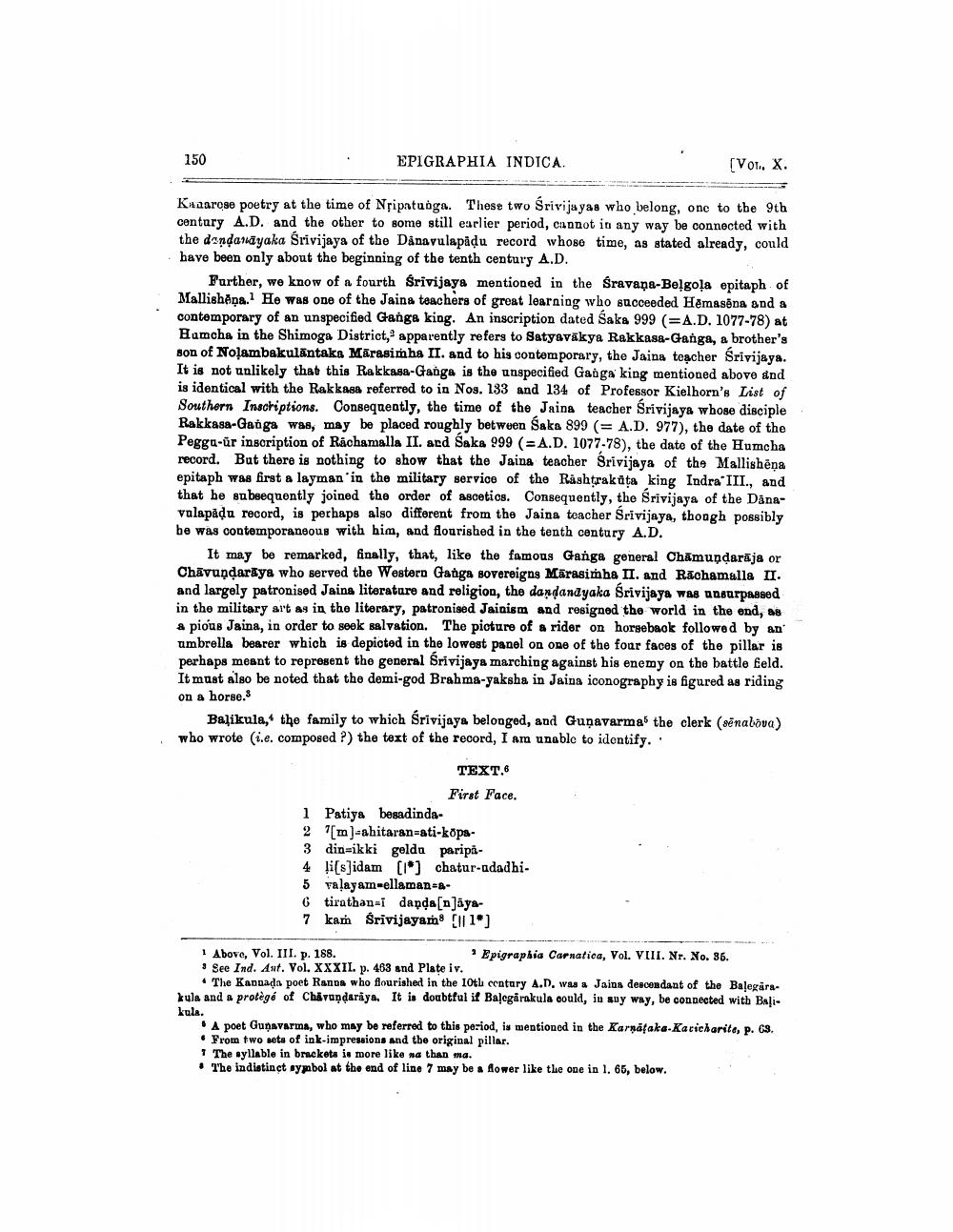________________
150
EPIGRAPHIA INDICA.
[Vol. X.
Kiarose poetry at the time of Nripatunga. These two Srivijayas who belong, one to the 9th century A.D. and the other to some still earlier period, unnot in any way be connected with the dandanayaka Srivijaya of the Dånavulapāņu record whoso time, as stated already, could have been only about the beginning of the tenth century A.D.
Further, we know of a fourth Srivijaya mentioned in the Sravana-Belgola epitaph of Mallishana. He was one of the Jaina teachers of great learning who succeeded Hēmasēna and a contemporary of an unspecified Ganga king. An inscription dated Saka 999 (=A.D. 1077-78) at Hamcha in the Shimoga District, apparently refers to Satyavákya Rakkasa-Ganga, a brother's son of Noļambakulāntaka Mārasimha II. and to his contemporary, the Jaina teacher Srivijaya. It is not unlikely that this Rakkasa-Ganga is the unspecified Ganga king mentioned above and is identical with the Rakkase referred to in Nos. 133 and 134 of Professor Kielhorn's List of Southern Inscriptions. Consequently, the time of the Jaina teacher Srivijaya whose disciple Rakkasa-Ganga was, may be placed roughly between Saka 899 (= A.D. 977), the date of the Pegga-ür inscription of Richamalla II. and Saka 999 (= A.D. 1077-78), the date of the Humcha record. But there is nothing to show that the Jaina teacher Srivijaya of the Mallishēņa epitaph was first a layman in the military service of the Rashtrakata king Indra III., and that he subsequently joined the order of ascetics. Consequently, the Srivijaya of the Dånavalapadu record, is perhaps also different from the Jaina teacher Srivijaya, though possibly be was contemporaneous with him, and flourished in the tenth century A.D.
It may be remarked, finally, that, like the famous Ganga general Chamundarāja or Chāvu darāya who served the Western Ganga sovereigns Mārasimha II. and Rachamalla II. and largely patronised Jaina literature and religion, the dandandyaka Srivijaya was unsurpassed in the military art as in the literary, patronised Jainism and resigned the world in the end, as a pious Jaina, in order to seek salvation. The picture of a rider on horseback followed by an umbrella bearer which is depicted in the lowest panel on one of the four faces of the pillar is perhaps meant to represent the general Srivijaya marching against his enemy on the battle feld. It must also be noted that the demi-god Brahma-yaksha in Jaina iconography is figured as riding on a horse.
Balikula, the family to which Srivijaya belonged, and Guņavarmas the clerk (sinabova) who wrote (.e. composed ?) the text of the record, I am unable to identify.'
TEXT.6
First Face. 1 Patiya besadinda2 [m]-ahitaran-ati-kops3 din=ikki gelda paripa - 4 li[s]idam (1") chatur-adadhi. 5 Falayam-ellaman-a6 tirathanai dapda[n]āya7 kam Srivijayam [l] 1*]
1 Above, Vol. III. p. 188.
Epigraphia Carnatioa, Vol. VIII. Nr. No. 36. * See Ind. Ant. Vol. XXXII. p. 463 and Plate iv.
• The Kannada poet Rands who flourished in the 10th century A.D. was a Jains descendant of the Balegarakula and a protege of Chavandaraya. It is doubtful if Balegarakula could, in suy way, be connected with Bali kula.
A poet Gunavarma, who may be referred to this period, is mentioned in the Karnataka-Kacicharita, p. 63. • From two sets of ink-impressions and the original pillar. 1 The syllable in brackets is more like na than ma. • The indistinct symbol at the end of line 7 may be a lower like the one in l. 65, below.




